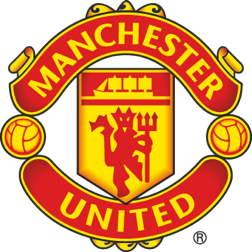Why Tommy Taylor was a goalscorer supreme
Ahead of the anniversary of the Munich Air Disaster, we look at how Tommy Taylor racked up an astonishing goalscoring record for club and county, at a rate unmatched in Manchester United history...
GOAT. The ‘greatest of all time’. It’s an acronym much loved in the social-media age; one in which fans pore obsessively over metrics such as xG, GCA and SCA to determine who has the best numbers. Stats have come to define the modern game’s ceaseless quest to find that extra, incremental edge through cold-eyed, granular analysis. Yet if you want the answer to the question: ‘who was United’s greatest centre-forward?’ in good old black and white, you’may need to go back to that grainy, pre-televised era.
Little footage exists of the six seasons Tommy Taylor played in a United shirt before Munich robbed football of his talents aged just 26 – or at least footage replete with the never-ending slow-motion close-ups and multi-camera angles that could do him justice. Not that it matters. Taylor’s numbers game – fittingly for a player so feted for his aerial ability – leaves the competition scrambling in the dirt. And those who saw him, never ever forgot him: the impression he left on fans and peers alike was indelible.
In 191 games for the Reds, Taylor found the net 131 times. That translates, number crunchers, as a staggering 0.686 strikes per match. It’s a figure not even Ruud van Nistelrooy, that arch penalty-box snaffler of the modern era, can better. It’s a close-run thing – but the Dutchman’s 0.685 goals per game (150 in 219 appearances) puts him second behind Taylor. And, let’s not forget, Ruud took spot-kicks and played on pitches players of the immediate post-War era would have deemed good enough for crown-green bowling compared with the sodden, undrained, lacking undersoil-heated affairs on which they plied their trade, with ‘case’ balls weighing the best part of two stone when wet.
Of United’s 22 marksmen to have reached 100 goals or more in all competitions, only Denis Law (237 at 0.587), Joe Cassidy (100 at 0.575), David Herd (145 at 0.547) and Taylor’s striking partner Dennis Viollet (0.611) managed better than a goal every other game – a figure generally perceived as the litmus test of a quality striker. Taylor’s tally places him 15th overall. But they didn’t amass them at the frequency Taylor did, and he was cruelly denied the power to add when approaching his peak.
His goals-to-game ratio for his country was more startling yet: 16 in 19 games for England – at 0.842 a pop. Many sages believe the World Cup of 1958 might well have been England’s, with Taylor leading the line, Bobby Charlton and David Pegg providing the ammunition, Roger Byrne leading the team, and Duncan Edwards, well, just being Duncan Edwards.
To put Taylor’s achievements in context, Wayne Rooney – United’s record goalscorer with 253 – has a positively pedestrian strike-rate of 0.453 in comparison; Jack Rowley, who stands fourth overall behind Charlton (249 at 0.328) and Law, struck his 211 at a rate of 0.498 per match.
The statistics tell only the half of Taylor’s incredible story. This, at least at the outset of his career, was a player whose abilities dwarfed rather modest ambitions: a seemingly ready-made poster-boy, but one stepped almost reluctantly into the spotlight. Spotted by Barnsley, having impressed with his local outfit Smithies United, he had spent two years prior to his national service barely playing any football after leaving school at 14, and, at one point, sported a pair of borrowed boots.
The well-worn tale surrounding his arrival at Old Trafford from Barnsley early in March 1953 for a club-record £29,999 – £1 was paid to Oakwell tea lady Lily Wilby to take the heat off his heavy price tag – appeared a canny stunt by Matt Busby. But perhaps it also spoke of a deeper desire on Taylor’s part to go at his own pace. A Yorkshire lad to his bones – one of a triumvirate alongside Mark Jones and David Pegg – he was even granted special dispensation to continue training with his old team-mates after the move.
It’s not hard to see why Busby was so set on him. Blessed with pace, power, balance, two good feet, and a great passing game, he critically also had an unflappable temperament that allowed him to keep cool when faced with students of the defensive dark arts, emboldened by the fact that they were unsanctioned by cards. Pursued by a host of clubs in the spring of 1952/53, having netted 20 goals for a Barnsley side ultimately bound for the third tier – scoring a hat-trick on only his second start – United had their man watched several times before moving in.
Taylor, who turned 21 that January, first appeared on United’s radar after Jones reported back on a torrid afternoon at his hands during a reserve outing. Busby’s post-1952 Championship puzzle picture was missing a piece: he needed a spearhead for his attack as he looked to shape a future without Jack Rowley.
Forever remembered
On the 66th anniversary, we take a glimpse at the lives of the players tragically killed in the Munich Air Disaster...
It had to be Taylor. He served notice immediately, finding the net twice on his debut in a 5-2 win against Preston North End on 7 March 1953; the first, typically, with a header – boomed in from the edge of the box. It became a trademark sight over the next five years. But this wasn’t your common-or-garden striker’s leap, courtesy of a battering-ram centre-forward, a la Nat Lofthouse or Tommy Lawton. This was something of his own.
Veteran United fan Roy Cavanagh likened his ability to hang in the air as almost supernatural; a man atop an invisible stepladder, in his own orbit, up there, waiting for the ball to find him. United have been blessed with some fine headers of the ball – one thinks of Denis Law, Joe Jordan, Zlatan Ibrahimovic – but perhaps only Cristiano Ronaldo’s Matrix-esque exquisite leaps, neck muscles coiled like a cobra, comes close to capturing Taylor’s signature style. During his Yorkshire youth, he was known for his ability to jump onto stone walls from a standing start. Another party piece showcasing his gymnast’s sense of balance involved standing astride a bucket, before leaping and balancing a foot on either handle.
Not only was he the perfect forward: he was the perfect team-mate. Viollet, with whom he plundered 83 league goals for the Babes’ back-to-back title-winners of 1955/56 and 1956/57, looked up to him, despite being less than two years his junior, in awe of his “beautiful, graceful movements”. “If you feel like you need a breather, just pass the ball to me,” Taylor would say to him. It was noted that the two could have found each other in the dark. Viollet – whose surname, curiously, was Taylor’s mother’s first name – quicksilver and a diminutive 5ft 8in, darting to pick up yet another knockdown from the bigger man. The space Taylor would create by – again, a rarity in those days of rigid tactics – dragging defenders wide with decoy runs, or dropping deep created havoc that was gleefully exploited by others, notably Billy Whelan – who topped the league scoring charts in 1956/57 with 26.
Taylor’s finest, or most-dramatic contribution arguably came on 6 February 1957, in the throes of United’s remarkable quarter-final comeback in the club’s inaugural European Cup campaign. Having left Bilbao with a glimmer of hope after Whelan’s late goal in the 5-3 first-leg defeat to Athletic Club, United had edged back into the contest at a pulsating Maine Road.
With six minutes left and 2-0 up Taylor, having scored the first, received the ball. Leaving two defenders in his wake, he powered down the right flank, shaped as if to shoot, only to square for Johnny Berry to thrash home the winner. It was a night those who were there still talk excitedly of today. Like Barça in ‘84, Rotterdam in ‘91, Turin and Barcelona in ‘99 – a game for the ages. It was his goal late on in the 1957 FA Cup final that offered United a glimmer of hope of that first post-War Double – Milan were on the phone with a £65,000 offer after that. United weren’t having it.
A year to the day from the Bilbao miracle, Taylor – United’s undisputed king of hide-and-seek when training was disrupted at The Cliff by fog rolling in off the River Irwell – and seven of his team-mates, were lost boys for real. Gone, yes, but never forgotten. Their smiles – particularly Tommy’s; the quiet man with a big, beaming grin that earned him the nickname ‘The Smiling Executioner’ – fixed in hearts and minds forever.




